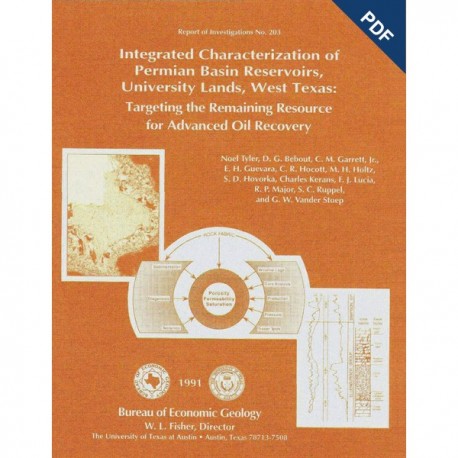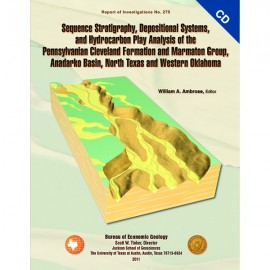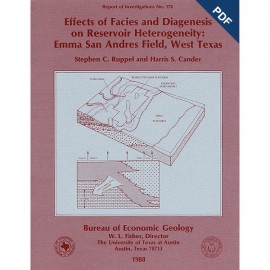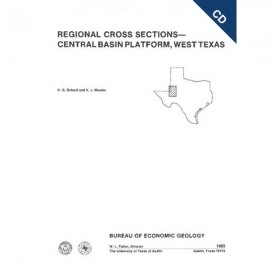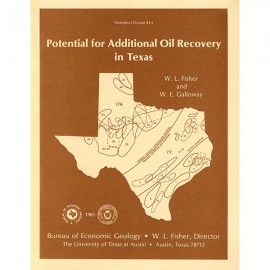Reports of Investigations
-
Books & Reports
- Reports of Investigations
- Guidebooks
- Udden Series
- Geological Circulars
- Down To Earth
- Atlases of Major Oil and Gas Reservoirs
- Texas Memorial Museum Publications
- Environmental Geologic Atlas of the Texas Coastal Zone
- Mineral Resource Circulars
- Other Reports
- Seminars and Workshops
- Handbooks
- Submerged Lands of Texas
- Symposia
- Annual Reports
- Open File Reports
-
Maps & Cross Sections
- Thematic Maps
- Miscellaneous Maps, Charts & Sections
- Geologic Atlas of Texas
- STATEMAP Project Maps
- Geologic Quadrangle Maps
- Cross Sections
- Highway Geology Map
- Energy and Mineral Resource Maps
- Shoreline Change and Other Posters
- Wilcox Group, East Texas, Geological / Hydrological Folios
- Bouguer Gravity Atlas of Texas
- River Basin Regional Studies
- Featured Maps
- Posters
- Teachers & the Public
-
Geological Society Publications
- Gulf Coast Association of Geological Societies
- Alabama Geological Society
- Austin Geological Society
- Corpus Christi Geological Society
- Houston Geological Society
- Lafayette Geological Society
- Mississippi Geological Society
- New Orleans Geological Society
- South Texas Geological Society
- GCS SEPM Publications
- Historic BEG & UT Series
Integrated Characterization of Permian Basin Reservoirs, University Lands, West Texas...Digital Download
RI0203D
Integrated Characterization of Permian Basin Reservoirs, University Lands, West Texas: Targeting the Remaining Resource for Advanced Oil Recovery, by N. Tyler, D.G. Bebout, C.M. Garrett, Jr., E.H. Guevara, C.R. Hocott, M.H. Holtz, S. D. Hovorka, C. Kerans, F.J. Lucia, R P. Major, S.C. Ruppel, and G.W. VanderStoep. 1991. doi.org/10.23867/RI0203D. Digital Version.
For a print version: RI0203.
RI0203D. Integrated Characterization of Permian Basin Reservoirs, University Lands, West Texas: Targeting the Remaining Resource for Advanced Oil Recovery, by Noel Tyler, D. G. Bebout, C. M. Garrett, Jr., E. H. Guevara, C. R. Hocott, M. H. Holtz, S. D. Hovorka, Charles Kerans, F. J. Lucia, R. P. Major, S. C. Ruppel, and G. W. Vander Stoep. 136 p., 67 figs., 2 tables, 1991. Downloadable. doi.org/10.23867/RI0203D.
To purchase this publication in book format, please order RI0203.
ABSTRACT
Unrecovered mobile oil is oil that is movable at reservoir conditions but is prevented from migrating to existing we1 l bores because of geologic complexities or heterogeneities. To assess the potential for incremental recovery of unrecovered mobile oil from reservoirs owned by The University of Texas System, the volumes of unrecovered mobile oil remaining in reservoirs on University Lands were quantified through integrated characterization of individual reservoirs. One hundred and one reservoirs, each of which has produced more than 1 million stock-tank barrels (MMSTB) of oil, were included in this resource assessment and play analysis. These reservoirs contained 7.25 billion stock-tank barrels (BSTB) of oil at discovery, have produced 1.5 BSTB, and contain 200 MMSTB of reserves. Ultimate recovery using current technology is projected to be 24 percent of the original oil in place; thus, 5.5 BSTB of oil will remain after recovery of existing reserves. Unrecovered mobile oil (exclusive of reserves) amounts to 2.2 BSTB, and immobile (residual) oil totals 3.3 BSTB.
These 101 University Lands reservoirs were grouped on the basis of geologic similarity into 11 major and minor plays. Three major plays, the San Andres/Grayburg Platform Carbonate, Siluro/Devonian carbonate, and Ellenburger Carbonate, dominate the resource base, collectively containing 67 percent of the oil in place and 60 percent of the unrecovered mobile oil. Ten reservoirs, Dune (Grayburg), Emma (San Andres), East Penwell (San Andres), Jordan (San Andres), Farmer (Grayburg), Taylor-Link West (San Andres), Three Bar (Devonian), Emma (Ellenburger), McFarland and Magutex (Queen), and Benedum (Spraberry), were selected for detailed analysis. Eight of the 10 reservoirs lie within the 3 major plays.
In each of 10 detailed reservoir studies, the location of unrecovered mobile oil in low-recovery reservoirs was found to depend upon lateral or vertical heterogeneity, or both. In reservoirs having a high degree of lateral heterogeneity such as the Spraberry submarine-fan reservoirs, the optimal recovery strategy is targeted infill drilling concentrated in areas of high remaining saturation. Where additional recovery targets exhibit vertical heterogeneity, such as in many Ellenburger reservoirs, deepening of existing wells supplemented by drilling of additional wells is appropriate. Most University Lands reservoirs, however, possess varying intensities of vertical and lateral heterogeneity. As a result, newly applied recovery strategies must account for both uncontacted reservoir compartments and saturated zones bypassed because of permeability stratification. Optimized recovery in this class of reservoir will incorporate infill drilling, waterflood optimization, and well recompletions.
Citation
Tyler, Noel, Bebout, D. G., Garrett, C. M., Jr., and others, 1991, Integrated Characterization of Permian Basin Reservoirs, University Lands, West Texas: Targeting the Remaining Resource for Advanced Oil Recovery: The University of Texas at Austin, Bureau of Economic Geology, Report of Investigations No. 203, 136 p.
